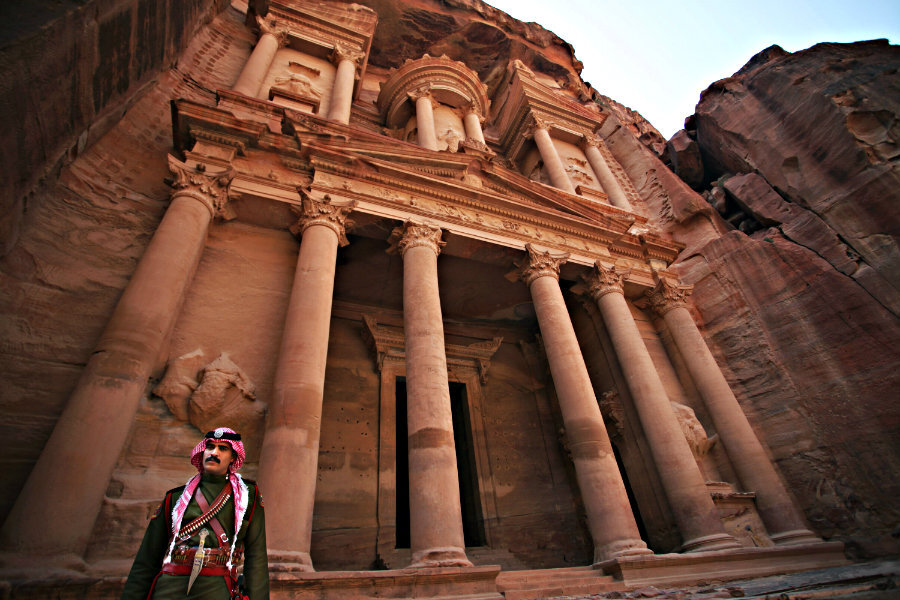New technology reveals enormous hidden monument in Petra, Jordan
Loading...
A new archeological discovery in the World Heritage site at Petra, Jordan, stunned the world after a study on the enormous monument was published in the Bulletin of the American Schools of Oriental Research last month.
The city of Petra is considered one of the "new seven wonders of the world." Although it has been well explored since its discovery by Johann Burckhardt in 1812, this particular site, located half a mile to the south of the city's center, had not yet been uncovered by centuries of archeologists.
Researchers familiar with the site, however, say that they were aware something else was out there.
"I'm sure that over the course of two centuries of research [in Petra], someone had to know [this site] was there, but it's never been systematically studied or written up," Christopher Tuttle, the director of the Council of Overseas Research Centers, told National Geographic. "I've worked in Petra for 20 years, and I knew that something was there, but it's certainly legitimate to call this a discovery."
Archeologists Sarah Parcak and Dr. Tuttle used drones and satellite imaging to discover the monument, which is the size of an Olympic swimming pool.
The structure that they discovered is described as a multi-level platform, 184 feet by 161 feet in size at its first level. The platform features a staircase up to a smaller, 28-foot-by-28-foot building that rests on top of the larger platform.
Archeologists say that the platform likely had a ceremonial function. If so, then the building is the second largest display area of its kind in Petra.
The monument is unusual in that its staircase does not face the city center, unlike staircases in other buildings in the city.
"This monumental platform has no parallels at Petra or in its hinterlands at present," wrote researchers, according to The Guardian.
The city of Petra was carved and constructed out of red sandstone by a tribal group called the Nabataeans, who established the site in the mid-second century BC. Archeologists say that the Nabataeans likely vacated the site in around the 7th century AD.
Pottery shards found at the recently discovered monument indicate that it may have been constructed in the first public building phase at Petra, around 2,150 years ago.
Tuttle and Dr. Parcak credit the use of satellite imaging with the magnificent find. Parcak in particular is known as a "space archeologist" for her use of satellite photos and other technology to identify historically and culturally significant sites.
This discovery at Petra is evidence that modern archeology has long since moved on from the dusty digging that contemporaries of Johann Burckhardt, the Swiss traveller who rediscovered Petra's ancient ruins in 1812, would have engaged in.
Today, archeologists have embraced the help of technology, using satellites and imaging technology to uncover previously hidden sites. Lidar, a new survey technology, has helped archeologists find hidden ruins in heavily forested areas in Central America.
Just last week, the Christian Science Monitor’s Lucy Schouten reported on the new technology that is enabling the search for hidden rooms in Egypt’s pyramids. In another find earlier this year, Parcak used satellite data to uncover a possible Viking site in North America. A Canadian teenager also grabbed headlines and stirred controversy when he used space archaeology and Google maps to hypothesize the location of a lost Mayan city.
"I think it makes what archaeologists do and find much more relevant to issues that we're struggling with today," ICOMOS International Scientific Committee on Archaeological Heritage Management Douglas Comer told the Monitor.
Still, space archeology's practitioners are careful to remind people of their responsibility while using this technology.
"This technology is not about what you find – but how you can think about things like settlement scale and ancient human-environment interactions more broadly," Parcak told The Guardian. "What happens when you can truly map the near-surface buried features for an entire site? I'm excited, but we need to think about the implications of having all this technology at our fingertips so we can use it responsibly."






